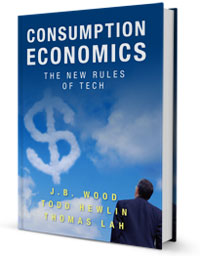This week, we present Chapter 6: Consumption Development: The Art and Science of Intelligent Listening. This is the seventh post in a series dedicated to helping MSPs understand and adopt the recommendations of Consumption Economics–The New Rules of Tech. Chuck introduces the chapter by sharing how the content resonates with his 30+ years of industry insight.
A FEW WORDS FROM CHUCK
Now we are getting to the heart of Consumption Economics (CE) and why I think it is such a valuable book for technology VARS and MSPs. The first five chapters of CE focus on the “what” and “why” of the seven shifts that have profoundly affected how tech companies operate, differentiate and generate revenue (as discussed in week 1). The next four chapters deal with “how” to transform your business model to survive and thrive in the new cloud based technology consumption model.
Chapter 6, Consumption Development – the Art and Science of Intelligent Listening deals with transforming the product development process. It is no longer necessary to predict customers’ needs two years into the future. Identifying customers’ current needs involves using data about customers’ usage patterns of current products (as described in Chapter 5 last week) and engaging in intelligent listening. Customers will talk to anyone about what they want and need; the key is actually listening to what they are saying. The result is the development of relevant, new products with features that customers will want to purchase and use TODAY.
The current reality is that customers desire products that are easier to use and only want to pay for features and functions that will make their work easier. Read the excerpt from Chapter 6 below. It will help you apply the Art and Science of Intelligent Listening to your product development process. Delivering relevant features and functions will drive new micro-transactions for your products and services, and generate recurring monthly revenues for you!
AN EXCERPT FROM Consumption Economics—The New Rules of Tech
 Chapter 6: Consumption Development – the Art and Science of Intelligent Listening
Chapter 6: Consumption Development – the Art and Science of Intelligent Listening
In a cloud world, traditional product development models are starting to feel a bit old school.
Where do those critical functionality decisions get made? How do we determine what’s included and what’s excluded when developing the product? We bet it all on the Market Requirements Document (MRD). Well, in the world of the cloud, the MRD is starting to look more like a boat anchor than a stairway to heaven.
The MRD is intended to be a roadmap for the product. Arguably, next to the core technical innovation itself, this has been seen as the most important determinant of a product’s success
or failure. In it are hundreds or thousands of educated guesses made by very bright people. The collective goal of those inputs to the development process is to accurately anticipate the market. And that point — that precise point about how best to anticipate the market — is what’s about to change.
Consumption Development has three major elements: Intelligent Listening, Consumption Innovation, and In-Product Upsell. Intelligent Listening takes advantage of user-level adoption and consumption data to predict the features and capabilities most likely to be wanted next. Consumption Innovation rebalances development investments from the traditional speeds and feeds toward entirely new capabilities designed to simplify and guide the end user along predetermined paths to more advanced features, new content, and new value. In-Product Upsell bakes in recommendation engines and offer-management capabilities so that we can tastefully inject consumption suggestions into the end-user experience in real time. In those cases where these offers result in revenue-generating MTs, we need to process those transactions.
Consumption Development removes much of R&D’s risk, radically improves its efficiency, and boosts its ROI. It creates better alignment between what the products can do and the value that end users and their companies can actually achieve. Your engineers are acting on the market’s needs, not trying to guess them two years in advance. Your best and brightest people, your company, and your customer’s company can now spend their time figuring out how to guide the users to where they want to go efficiently and effectively in the real-time course of the product’s use.
Because D3UC is dedicated to and entrenched with the MSP community, each week a new chapter of Consumption Economics will be discussed with emphasis focused on the challenges faced by VARs and MSPs who are transforming their companies’ business models to survive and thrive in the new, Cloud-driven world.
If you would like an overview of the book Consumption Economics, you can download a copy of the “abridged” version written by the TSIA from our website.
Week 2: How Good We Had It: The Money-Making Machine Known as High-Tech
Week 3: Shifting Clouds and Changing Rules
Week 4: Looking Over the Margin Wall
Week 5: Learning to Love Micro-Transactions
Week 6: The Data Piling Up in the Corner
Week 7: Consumption Development: The Art and Science of Intelligent Listening
Week 8: Consumption Marketing: Micro-Marketing and Micro-Buzz
Week 9: Consumption Sales: After a Great Run, the Classic Model Gets an Overhaul
Week 10: Consumption Services: Will They Someday Own “The Number”?
Week 11: How Fast Should You Transform?
Week 12: A Few Words From Chuck – The Epilogue
Published: June 2015
Reviewed: November 2016, March 2018

